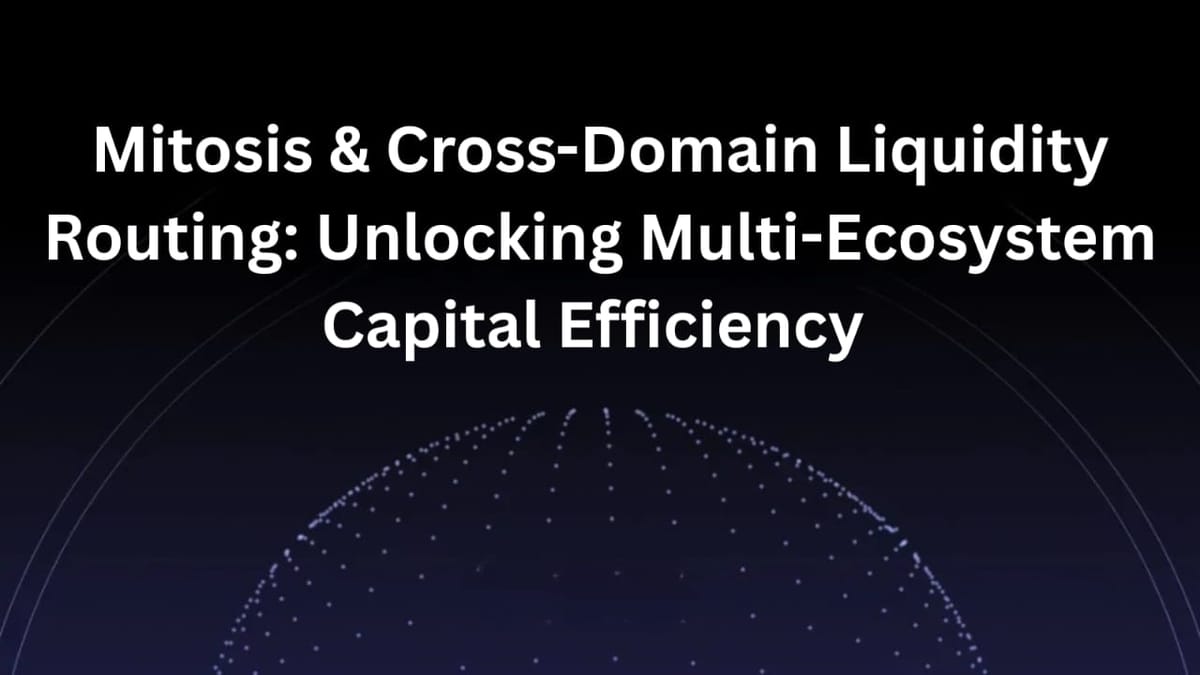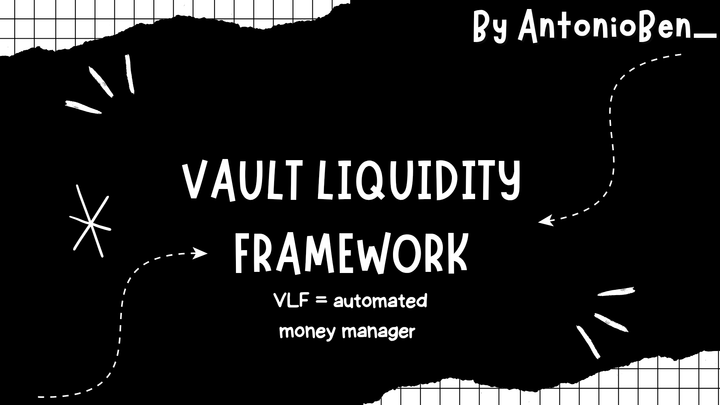Mitosis & Cross-Domain Liquidity Routing: Unlocking Multi-Ecosystem Capital Efficiency

Introduction
In the rapidly evolving landscape of decentralized finance (DeFi), liquidity remains a critical component for the success of any financial ecosystem. As various blockchain networks emerge, the challenge of liquidity fragmentation becomes increasingly apparent. Different ecosystems often operate in isolation, leading to inefficiencies and missed opportunities for capital deployment. Mitosis emerges as a groundbreaking solution that addresses these challenges by enabling cross-domain liquidity routing, acting as a bridge-layer for rollup-native DeFi. This article delves into the intricacies of Mitosis, its operational mechanisms, and its potential to revolutionize liquidity management in the DeFi space.
1. Understanding Liquidity Fragmentation
1.1 The Challenge of Fragmented Liquidity
Liquidity fragmentation occurs when assets are trapped within specific blockchain ecosystems, preventing them from being utilized efficiently across different platforms. This fragmentation results in several challenges:
- Siloed Ecosystems: Different blockchain networks often operate independently, leading to liquidity being confined within specific ecosystems. This isolation can create inefficiencies and limit the potential for capital deployment.
- Inefficient Capital Utilization: Investors and liquidity providers face challenges in maximizing returns due to the inability to move assets freely across chains. This inefficiency can lead to higher volatility and reduced market depth.
- Increased Slippage: When liquidity is fragmented, traders may experience increased slippage when executing trades, as they may not have access to the best prices across different platforms.
- Limited Yield Opportunities: Users may miss out on lucrative yield farming opportunities available on other chains due to the difficulty of transferring assets between ecosystems.
1.2 The Need for Cross-Domain Solutions
As DeFi continues to grow, the need for interoperability between various blockchain networks becomes paramount. Cross-domain liquidity routing allows for the seamless transfer of assets, enhancing overall market efficiency. Key benefits include:
- Interoperability: Cross-domain solutions enable different blockchain networks to communicate and share liquidity, fostering a more interconnected DeFi ecosystem.
- Capital Efficiency: By allowing assets to work across multiple ecosystems, Mitosis enhances capital efficiency, enabling users to earn yields in various DeFi protocols without the need for manual asset transfers.
- Improved Market Depth: Cross-domain liquidity routing contributes to deeper markets, improving price stability and reducing slippage for traders.
- Enhanced User Experience: Users can access a broader range of financial products and services without the barriers of traditional liquidity protocols, simplifying their interactions with DeFi.
2. Mitosis: The Bridge-Layer of Rollup-Native DeFi
2.1 What is Mitosis?
Mitosis is a Layer 1 blockchain designed to unify fragmented crypto liquidity by enabling assets to be deployed across multiple chains simultaneously. It introduces innovative concepts such as Ecosystem Owned Liquidity (EOL), miAssets, and a cross-chain vault system, all aimed at enhancing capital efficiency and reducing volatility.
2.2 Key Features of Mitosis
- Ecosystem Owned Liquidity (EOL):
- miAssets:
- Cross-Chain Vault System:
- Automated Liquidity Routing:
- Mitosis utilizes smart contracts to automate the routing of liquidity between chains, ensuring that assets are deployed where they can earn the highest yields without manual intervention.
3. How Mitosis Enables Cross-Domain Liquidity Routing
3.1 The Mechanism of Cross-Domain Liquidity Routing
- Modular Blockchain Design:
- Mitosis features a modular architecture that adapts to the unique requirements of different blockchain networks, facilitating seamless integration and interaction.
- Liquidity Pools:
- Users can deposit assets into Mitosis liquidity pools, which are then utilized across various DeFi protocols, ensuring that capital is always working to generate returns.
- Dynamic Asset Allocation:
- Mitosis employs algorithms to analyze market conditions and dynamically allocate assets to the most profitable opportunities across different chains.
- Cross-Chain Communication:
- Mitosis leverages cross-chain communication protocols to facilitate the transfer of assets and data between different blockchain networks, enhancing interoperability.
3.2 Benefits of Cross-Domain Liquidity Routing
- Increased Yield Opportunities: Users can access a broader range of yield farming opportunities across multiple chains, maximizing their potential returns.
- Reduced Transaction Costs: By minimizing the need for manual transfers between chains, Mitosis reduces transaction fees and enhances overall cost efficiency.
- Enhanced Market Depth: Cross-domain liquidity routing contributes to deeper markets, improving price stability and reducing slippage for traders.
- Simplified User Experience: Users can interact with multiple DeFi protocols without the need for complex asset transfers, streamlining their experience.
4. The Role of MITO Token in the Mitosis Ecosystem
4.1 Overview of the MITO Token
The MITO token serves as the backbone of the Mitosis ecosystem, playing a crucial role in governance, security, and liquidity provisioning.
- Governance:
- MITO token holders have the right to participate in governance decisions, influencing the future direction of the Mitosis protocol.
- Staking and Security:
- Users can stake MITO tokens to secure the network, earning rewards while contributing to the overall stability and security of the ecosystem.
- Liquidity Incentives:
- The MITO token incentivizes liquidity provision, rewarding users for contributing to liquidity pools and enhancing the overall capital efficiency of the Mitosis platform.
- Fee Structure:
- Transaction fees generated within the Mitosis ecosystem can be distributed to MITO token holders, providing an additional incentive for participation.
5. Real-World Applications of Mitosis
1. Multi-Chain Yield Optimization
Mitosis enables users to automatically place their assets in the most lucrative yield farming opportunities across various blockchain networks. For instance, a user could deposit ETH into Mitosis and have portions of its value working on Solana, Avalanche, and Polygon simultaneously, all while maintaining quick access to their funds.
2. Interoperability Solutions
Mitosis facilitates the movement of value between previously incompatible networks, allowing users to leverage the strengths of different ecosystems without the barriers of traditional liquidity protocols. This interoperability can lead to the creation of new financial products and services that were previously unattainable.
3. Liquidity Derivatives
The Mitosis framework allows for the creation of new financial instruments based on cross-chain liquidity positions, enabling innovative trading strategies and investment opportunities. For example, users could create derivatives that track the performance of liquidity pools across multiple chains, providing exposure to a diversified set of assets.
4. Cross-Chain Arbitrage
Mitosis enables users to engage in cross-chain arbitrage opportunities, where they can exploit price discrepancies between different blockchain networks. By routing liquidity efficiently, users can capitalize on these opportunities, enhancing overall market efficiency.
6. Challenges and Considerations
1. Data Privacy and Security
While Mitosis enhances liquidity routing, it also raises concerns about data privacy and security. Ensuring that user data remains confidential while facilitating cross-chain transactions is crucial for maintaining trust in the ecosystem. Implementing robust security measures, such as encryption and decentralized identity solutions, will be essential.
2. Regulatory Compliance
As Mitosis and similar projects gain traction, navigating the regulatory landscape will be essential. Compliance with existing regulations while fostering innovation will be a balancing act for the Mitosis team. Engaging with regulators and industry stakeholders will be crucial to ensure that Mitosis operates within legal frameworks.
3. Market Volatility
The inherent volatility of cryptocurrency markets can impact the effectiveness of cross-domain liquidity routing. Mitosis must implement robust risk management strategies to mitigate potential losses for users. This may include mechanisms to protect against sudden market fluctuations and ensure that liquidity remains stable.
4. User Education
As Mitosis introduces new concepts and mechanisms, educating users about how to navigate the platform will be essential. Providing clear documentation, tutorials, and support resources will help users understand the benefits and risks associated with cross-domain liquidity routing.
7. The Future of Mitosis and Cross-Domain Liquidity Routing
Trends to Watch
- Increased Adoption of Layer 2 Solutions: As Layer 2 solutions gain popularity, Mitosis will likely play a crucial role in facilitating liquidity routing across these networks, enhancing overall capital efficiency.
- Expansion of DeFi Ecosystems: As more DeFi platforms emerge, the need for cross-domain liquidity routing will become increasingly important. Mitosis can serve as a foundational layer for these new ecosystems.
- Integration with Traditional Finance: The potential for Mitosis to bridge the gap between DeFi and traditional finance will be a key area of focus. Collaborations with financial institutions could lead to innovative products that leverage cross-domain liquidity.
- Enhanced Interoperability Standards: As the DeFi space matures, the development of standardized protocols for cross-chain communication will be essential. Mitosis can contribute to these standards, promoting greater interoperability across the ecosystem.
- Focus on Sustainability: As the DeFi space evolves, there will be an increasing emphasis on sustainable liquidity models. Mitosis's Ecosystem Owned Liquidity (EOL) approach aligns with this trend, promoting long-term stability and predictability.
Conclusion
Mitosis represents a significant advancement in the DeFi landscape, addressing the challenges of liquidity fragmentation and enabling efficient capital allocation across multiple ecosystems. By facilitating cross-domain liquidity routing, Mitosis enhances capital efficiency, reduces volatility, and fosters interoperability among various DeFi platforms. As the project continues to evolve, it holds the potential to reshape the future of liquidity management in decentralized finance.



Comments ()